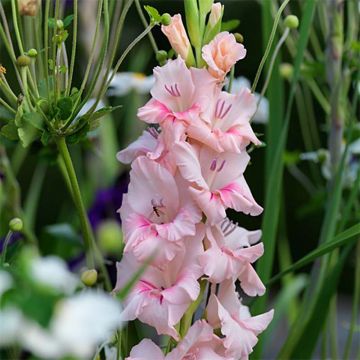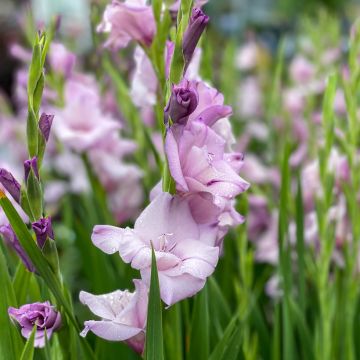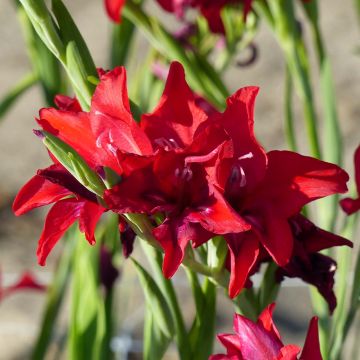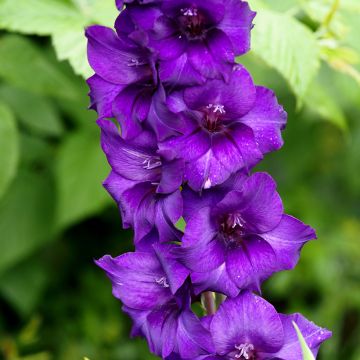

Dwarf Gladiolus Collection
Dwarf Gladiolus Collection
Gladiolus nanus Elvira, Charming Beauty
This item cannot be shipped to the selected country
Delivery charge from €5.90
More information
Schedule delivery date,
and select date in basket
This plant carries a 6 months recovery warranty
More information
We guarantee the quality of our plants for a full growing cycle, and will replace at our expense any plant that fails to recover under normal climatic and planting conditions.
From €5.90 for pickup delivery and €6.90 for home delivery
Express home delivery from €8.90.
Does this plant fit my garden?
Set up your Plantfit profile →
Collection items (30 plants)
Description
This is a collection of dwarf gladioli, shorter than their large-flowered cousins, but also more resistant to cold. It consists of the pretty varieties 'Elvira' and 'Charm', renowned for the delicacy and beauty of their flowers, in shades of pink to white. The bulbs can remain in the ground in many regions, with good winter mulching. They look beautiful everywhere: in a vase, in a flower bed, in borders, and in pots! Offer them a fresh but well-drained soil, and a sunny exposure.
This collection consists of:
- 'Elvira' Colvillei gladioli: an old variety, 70-80 cm (28-32in) tall when in bloom, with very pale pink flowers adorned with small dark pink diamond-shaped motifs on the lower petals. Up to 6 buds per flower spike, and 2 or 3 flower spikes per corm. The flowers generally bloom in July (sometimes as early as June), along rather tall flower spikes for a dwarf gladiolus.
- 'Charm' gladioli: reaching a height of 65 cm (26in) when in bloom, this variety produces one or several inflorescences. The small-sized flowers are brightly colored, in cherry pink washed with purple-pink, with the lower sepal speckled with white near the throat. Blooms in July.
These varieties are labelled separately.
Cultivated gladioli, belonging to the family Iridaceae, are hybrid plants. They are divided into 3 main groups: Grandiflorus (large-flowered), Primulinus (early), and Nanus (butterflies). 'Elvira' and 'Charm' both belong to the Nanus group. These hybrids are characterised by smaller flowers, irregularly arranged on stems not exceeding 70 cm (28in) in height, each bearing up to 7 florets quite spaced apart. The lower petal of each star-shaped flower has a darker or lighter central zone. They are herbaceous perennial plants. These gladioli are also known for their cold resistance, up to -12°C (10.4°F) under protective mulch. The leaves are elongated, sword-shaped, with parallel veins, 3-4 cm (1-2in) wide, arranged in a fan shape. The gladiolus grows in spring and dries up at the end of summer.
Shorter and more refined than the large hybrids with big flowers, the dwarf 'Elvira' and 'Charm' gladioli easily fit into simple perennial or low shrub borders, often without needing staking. Their pink and white blooms go well with groundcover roses (The Fairy, Mareva, Opalia), small grasses (Stipa pennata or tenuifolia), catmints, penstemons, perennial salvias, and Diascia, for example. Play with the vivid blue of perennial flax and the delicate pink of baby's breath for brightness, and add here and there some silver foliage (stachys, cotton lavenders, artemisias). For making bouquets, cut the flower spikes when the first floret starts to open. Plant them at intervals of two weeks from early spring to the end of June to have flowers in the house and garden all summer.
The gladiolus gets its name from the shape of its sword-like leaves, derived from the Latin word "gladius". Its wild forms were often represented in jewellery or on carpets and fabrics made by the Semitic people before the Christian era.
Report an error about the product description
Dwarf Gladiolus Collection in pictures




Plant habit
Flowering
Foliage
Botanical data
Gladiolus
nanus
Elvira, Charming Beauty
Iridaceae
Cultivar or hybrid
Other Gladioli
Planting and care
Plant the bulbs of the Dwarf Gladiolus in well-drained soil and in a sunny location, sheltered from the wind. Bury them under 8 to 10 cm (3 to 4in) of soil, spaced 10 to 15 cm (4 to 6in) apart.
Gladioli like rich, fertile but well-drained soils, sbut dislikes compact clay. Avoid using manure to fertilize the soil, as it promotes bulb rot. The plant should not lack water during its growth and flowering period, but its bulbs appreciate being dry during the resting period. The corms of these varieties can overwinter in the ground, in a well-drained, very healthy soil, covered with a thick mulch to prevent damage from severe frost. They can withstand temperatures as low as -12°C (10.4°F) for a short period of time and under a thick protective mulch. In very cold regions, the plants should be dug up as soon as the leaves have turned yellow, to be stored in turf and kept dry, protected from heat and frost. You can also grow them in pots that you will protect from the cold, 20 bulbs for a pot of 20 to 22 cm (8 to 9in).
Planting period
Intended location
Care
-
, onOrder confirmed
Reply from on Promesse de fleurs
Haven't found what you were looking for?
Hardiness is the lowest winter temperature a plant can endure without suffering serious damage or even dying. However, hardiness is affected by location (a sheltered area, such as a patio), protection (winter cover) and soil type (hardiness is improved by well-drained soil).

Photo Sharing Terms & Conditions
In order to encourage gardeners to interact and share their experiences, Promesse de fleurs offers various media enabling content to be uploaded onto its Site - in particular via the ‘Photo sharing’ module.
The User agrees to refrain from:
- Posting any content that is illegal, prejudicial, insulting, racist, inciteful to hatred, revisionist, contrary to public decency, that infringes on privacy or on the privacy rights of third parties, in particular the publicity rights of persons and goods, intellectual property rights, or the right to privacy.
- Submitting content on behalf of a third party;
- Impersonate the identity of a third party and/or publish any personal information about a third party;
In general, the User undertakes to refrain from any unethical behaviour.
All Content (in particular text, comments, files, images, photos, videos, creative works, etc.), which may be subject to property or intellectual property rights, image or other private rights, shall remain the property of the User, subject to the limited rights granted by the terms of the licence granted by Promesse de fleurs as stated below. Users are at liberty to publish or not to publish such Content on the Site, notably via the ‘Photo Sharing’ facility, and accept that this Content shall be made public and freely accessible, notably on the Internet.
Users further acknowledge, undertake to have ,and guarantee that they hold all necessary rights and permissions to publish such material on the Site, in particular with regard to the legislation in force pertaining to any privacy, property, intellectual property, image, or contractual rights, or rights of any other nature. By publishing such Content on the Site, Users acknowledge accepting full liability as publishers of the Content within the meaning of the law, and grant Promesse de fleurs, free of charge, an inclusive, worldwide licence for the said Content for the entire duration of its publication, including all reproduction, representation, up/downloading, displaying, performing, transmission, and storage rights.
Users also grant permission for their name to be linked to the Content and accept that this link may not always be made available.
By engaging in posting material, Users consent to their Content becoming automatically accessible on the Internet, in particular on other sites and/or blogs and/or web pages of the Promesse de fleurs site, including in particular social pages and the Promesse de fleurs catalogue.
Users may secure the removal of entrusted content free of charge by issuing a simple request via our contact form.
The flowering period indicated on our website applies to countries and regions located in USDA zone 8 (France, the United Kingdom, Ireland, the Netherlands, etc.)
It will vary according to where you live:
- In zones 9 to 10 (Italy, Spain, Greece, etc.), flowering will occur about 2 to 4 weeks earlier.
- In zones 6 to 7 (Germany, Poland, Slovenia, and lower mountainous regions), flowering will be delayed by 2 to 3 weeks.
- In zone 5 (Central Europe, Scandinavia), blooming will be delayed by 3 to 5 weeks.
In temperate climates, pruning of spring-flowering shrubs (forsythia, spireas, etc.) should be done just after flowering.
Pruning of summer-flowering shrubs (Indian Lilac, Perovskia, etc.) can be done in winter or spring.
In cold regions as well as with frost-sensitive plants, avoid pruning too early when severe frosts may still occur.
The planting period indicated on our website applies to countries and regions located in USDA zone 8 (France, United Kingdom, Ireland, Netherlands).
It will vary according to where you live:
- In Mediterranean zones (Marseille, Madrid, Milan, etc.), autumn and winter are the best planting periods.
- In continental zones (Strasbourg, Munich, Vienna, etc.), delay planting by 2 to 3 weeks in spring and bring it forward by 2 to 4 weeks in autumn.
- In mountainous regions (the Alps, Pyrenees, Carpathians, etc.), it is best to plant in late spring (May-June) or late summer (August-September).
The harvesting period indicated on our website applies to countries and regions in USDA zone 8 (France, England, Ireland, the Netherlands).
In colder areas (Scandinavia, Poland, Austria...) fruit and vegetable harvests are likely to be delayed by 3-4 weeks.
In warmer areas (Italy, Spain, Greece, etc.), harvesting will probably take place earlier, depending on weather conditions.
The sowing periods indicated on our website apply to countries and regions within USDA Zone 8 (France, UK, Ireland, Netherlands).
In colder areas (Scandinavia, Poland, Austria...), delay any outdoor sowing by 3-4 weeks, or sow under glass.
In warmer climes (Italy, Spain, Greece, etc.), bring outdoor sowing forward by a few weeks.















































